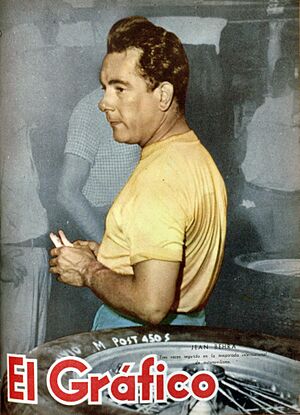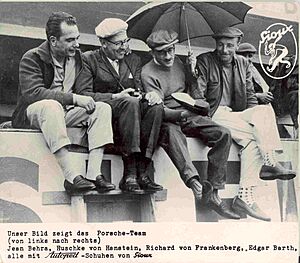Jean Behra facts for kids
Quick facts for kids
Jean Behra
|
|
|---|---|
 |
|
| Born |
Jean Marie Behra
16 February 1921 |
| Died | 1 August 1959 (aged 38) |
| Nationality | |
| Relatives | José Behra (brother) Jean-Paul Behra (son) |
| Formula One World Championship career | |
| Active years | 1952 – 1959 |
| Teams | Gordini, Maserati, BRM, Ferrari |
| Entries | 53 (52 starts) |
| Championships | 0 |
| Wins | 0 |
| Podiums | 9 |
| Career points | 51 1⁄7 |
| Pole positions | 0 |
| Fastest laps | 1 |
| First entry | 1952 Swiss Grand Prix |
| Last entry | 1959 French Grand Prix |

Jean Marie Behra (born 16 February 1921 – died 1 August 1959) was a famous French Formula One race car driver. He competed for several top teams, including Gordini, Maserati, BRM, Ferrari, and Porsche. Jean Behra was known for his fierce driving style and strong personality.
Contents
Meet Jean Behra: His Look and Spirit
Jean Behra was not very tall, but he was strong and muscular. He weighed about 178 pounds. His body showed many scars from the 12 car crashes he had been in. In 1955, he even had part of an ear torn off in a collision.
Sometimes, Behra drove incredibly well, showing amazing skill. Other times, he seemed less excited about racing. He was known for being very determined and sometimes quick to get angry. This led to problems with his team managers at Scuderia Ferrari. He was accused of pushing the engines too hard during races. After a big disagreement with a team manager, he was let go from the Ferrari team shortly before he died.
Jean Behra's Racing Journey
Before racing cars, Jean Behra was a motorcycle racer for Moto Guzzi. In January 1950, he took third place in the Monte Carlo Rally while driving a Simca 8 coupé. He started racing cars professionally in 1952. Another famous driver, Joakim Bonnier, said he learned most of his racing skills from Behra.
Even though Jean Behra never won a Formula One World Championship race, he loved motorsport very much. He was considered a very tough competitor right up until his death. He first gained attention when he won the 1952 Reims Grand Prix, which was not a championship race. Between 1952 and 1959, he won many other races, but none were official Formula One championship events.
Driving for Gordini
In November 1952, Behra raced a Gordini in the Carrera Panamericana road race in Mexico. He won the first part of this five-day race. He started in 19th place and finished with a time of 3 hours, 41 minutes, and 44 seconds. However, on the second day, Behra crashed his car about 50 miles from Puebla.
In April 1954, Behra won the Grand Prix of Pau, France. He passed the leader in the final ten minutes of the race. He finished about 200 yards ahead of Maurice Trintignant. Behra had to make many pit stops because of mechanical problems with his six-cylinder Gordini car.
Success with Maserati
Jean Behra won the Grand Prix de Pau again the next year, 1955. This time, he was driving a Maserati. Alberto Ascari was leading, but he had to slow down after his brakes failed. A crowd of 50,000 people watched the race. Only eleven of the sixteen cars that started actually finished.
Behra and Luigi Musso were teammates in the Supercortemaggiore Grand Prix in Monza, Italy. They shared a 3000cc Maserati car. They won the race and set new records for the track.
In June 1956, Behra had leg surgery and missed a race in Monza. But in July 1956, he earned the top starting spot for the Rouen Grand Prix. His Maserati reached an average speed of almost 155.46 kilometers per hour. In October 1956, Behra won the Grand Prix of Rome in a 2000cc Maserati sports car. He covered 166.030 kilometers to win. He also set a new lap record for the Castelfusano track.
The year 1956 was Behra's best season in the Formula One World Championship. He finished 4th overall in the championship. He achieved five podium finishes (meaning he finished in the top three) in seven races.
In April 1957, Behra had the fastest practice time for the Pau Grand Prix. He completed the 2.77-meter course in 1 minute and 35.7 seconds. This was just half a second slower than his own lap record. He won the race, which was held on the streets of Pau, with an average speed of 62.7 miles per hour.
Behra was hurt while testing a car in May 1957. But he recovered and raced a Maserati in the 24 hours of Le Mans on June 22. He then won a race in a Maserati in Kristianstad, Sweden, in August 1957. He followed this with another win in the Grand Prix of Modena, Italy, in September.
Driving for Porsche
Jean Behra drove a Porsche to win the 6th Rouen Grand Prix. He beat British drivers Graham Hill and Alan Stacey. In the 1958 Portuguese Grand Prix at Oporto, Behra finished 4th while driving for BRM.
In September, he won the Grand Prix of Berlin, Germany, in a Porsche. He completed twenty laps of the 5.19-kilometer track in 48 minutes, 14.8 seconds, averaging 128.2 miles per hour. In 1958, he won eight straight European races, all in a Porsche Spyder sports car. In Formula One that year, he raced only for BRM.
In October 1958, Behra finished 4th at Riverside International Raceway in a small Porsche RSK. He quickly left for Europe to race in the Grand Prix of Morocco at Casablanca. He was in such a hurry that he took an ambulance from Riverside, California, to catch his flight.
Jean Behra's Final Season and Tragic Death
In 1959, Jean Behra joined the Ferrari team, partnering with Tony Brooks. In April 1959, Behra won a 200-mile international Formula One race at Aintree. He averaged 88.7 miles per hour, finishing 10 seconds ahead of Brooks.
While still with Ferrari, he started working on a new Formula Two car based on a Porsche 718 RSK. This team, called Behra-Porsche, entered the 1959 Monaco Grand Prix. Even though they didn't qualify, Behra found the project "tremendous fun." His efforts paid off when Hans Herrmann drove the car to second place in the important Reims F2 race. This race was held before the 1959 French Grand Prix. Behra's car actually beat Ferrari's own F2 entries, which made Enzo Ferrari very angry. This made the relationship between Behra and Ferrari even worse.
Things got even more difficult after Behra had to stop racing in the French Grand Prix due to an engine problem. Later that weekend, he had a very heated argument in a restaurant. This led to his immediate dismissal from the Ferrari team.
Less than a month later, on August 1, 1959, Jean Behra crashed his Porsche RSK. It was raining during a sports car race before the German Grand Prix at AVUS in Berlin, Germany. He was thrown from his car and hit a flagpole, which caused a fatal skull fracture.
The sports car race was for smaller cars with engines under 1,500 c.c. After three laps, Behra was in third place. The AVUS track was very unusual. It used a 2.5-mile strip of the Autobahn. At one end was a sharp turn, and at the other was a 30-foot-high, steeply banked loop. Behra lost control in the pouring rain while going 110 miles per hour. His Porsche spun and went over the top of the banking. It landed on its side, wrecked. Behra was thrown out and hit one of the flagpoles at the top of the banking. The flagpole fell over when he hit it.
Behra landed in some trees near a street where drivers often waited. A doctor quickly arrived but could not help him. A hospital report said Behra broke most of his ribs, in addition to the skull fracture that caused his death. Today, AVUS is part of the German highway system, known as Autobahn A 115.
Remembering Jean Behra
Jean Behra was buried in Nice, France, on August 7, six days after his crash. There were three funeral services for him: one in Berlin, one in Paris, and the final one in Nice. At the Nice service, 3,000 people lined the streets to mourn him.
Jean Behra left behind his nineteen-year-old son, Jean Paul. After Behra's death, Maurice Trintignant was one of the few famous French drivers still alive. Trintignant comforted Behra's family and encouraged young French men to continue racing for their country. Interestingly, Enzo Ferrari was not present at the funeral services. He had dismissed Behra from his team just ten days before his death.
Images for kids
See also
 In Spanish: Jean Behra para niños
In Spanish: Jean Behra para niños


